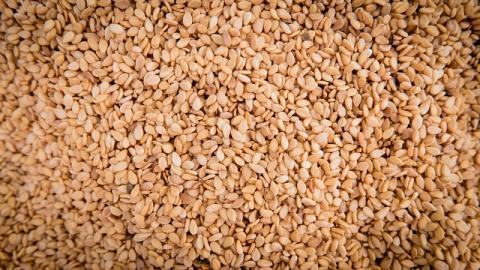
Tahini is ground sesame seeds – it’s a product which is rich in nutrients and has been used in recipes and as a healing agent for centuries. The sesame plant is native to India and was found growing naturally from northeastern Africa to the far east. The seeds were primarily used for their oil, as a base for perfumes and as a seasoning. The name sesame is derived from the ancient Egyptian word sesemt and later from the Greek word sesamon. The plant continues to grow wild throughout India. The sesame plant came to America with the slaves from the Mandingo County on the upper Niger River in Africa who were relocated to North Carolina. They called the sesame plant “benni” and pounded the seeds into a paste, tahini, and used this paste with hominy as well as many other recipes to add protein to their diet.
Tahini has the same food value as sesame seeds because it is just the ground seeds. Its benefit to the body makes it a valuable addition to the diet. The richest nutritional value of tahini is made with organic un-hulled sesame seeds that are washed, dried and slowly roasted before they are ground. Un-hulled tahini is darker, has the most nutritional value and has a nuttier flavor than hulled tahini. Organic tahini can be used in many recipes.
Here are 4 reasons to welcome tahini into your life:
1. Tahini contains two unique fibers called lignans: sesamin and sesamolin. These have been shown to lower cholesterol, increase vitamin E in the body and prevent high blood pressure. Sesamin has been found to protect the liver from damage due to oxidation.
2. Tahini is rich in copper, which is a trace mineral essential to the body. It reduces swelling and pain and is used in the treatment of rheumatoid arthritis. It is also a catalyst for the enzyme lysyl oxidase which is a factor in the health of blood vessels, bones and joints.
3. Calcium is another mineral that is concentrated in tahini. It is essential for the health of the colon, preventing cancer-causing chemicals from damaging the cells. It prevents bone loss and is used in the treatment of osteoporosis and rheumatoid arthritis. It is also beneficial in controlling PMS and migraine headaches. One tablespoon of un-hulled tahini contains approximately eighty-eight milligrams of calcium, while the same amount of hulled tahini contains about thirty-seven milligrams of calcium.
4. Tahini is also a very good source of manganese, magnesium, phosphorus, iron, zinc, molybdenum and selenium. It contains a rich amount of vitamins B1, B2, B3, B5 and B15. These vitamins relieve stress, reduce the risk of heart attacks, aid in the increase of memory and can reduce the incidents of anxiety and depression.
Halva Treats
Ingredients
2 cups Honey
1 ½ cups Tahini
1 ½ cups Pistachio nuts
Directions
1. In a sauce pan heat the honey to 250 F degrees until it reaches “soft ball stage.” This can be confirmed by placing a spoon filled with the heated honey in cold water which becomes a soft ball in the water and flattens when removed from the water. Once to this stage take off the heat and set aside.
2. In a separate sauce pan heat the tahini to 120 F degrees or until warm.
3. Add the warm tahini to the honey in the sauce pan and mix thoroughly until the honey and tahini are thoroughly blended and has a smooth consistency.
4. Once the mixture reaches a smooth consistency, add the pistachio nuts and mix thoroughly until the consistency becomes stiff, about eight minutes.
5. Pour into a well-greased loaf pan or a pan with a removable bottom and let cool at room temperature. Then refrigerate for approximately 36 hours.
6. Remove from pan and cut into serving pieces. Tightly wrap the halva that is not eaten in plastic wrap -- it will keep for months in the refrigerator.








